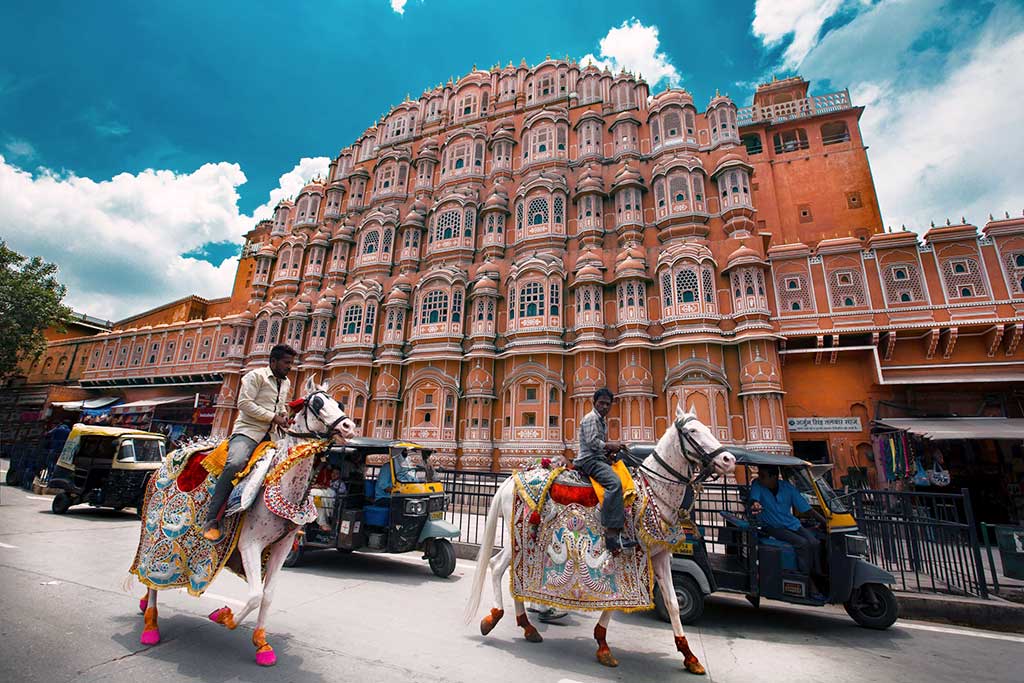A trip to Jaipur is a journey through the roots of Rajasthan. One of India’s most culturally rich cities, Jaipur boasts of majestic forts and palaces, exquisite gardens, delicious street food, colourful markets, and much more. Here’s a two day itinerary to help you get the most out of your stay.

Day 1:
The best way to begin is at Amer Fort a few kilometres away from the city. The journey to Amer is perfect to get a glimpse of Jaipur and its surroundings. The unmissable Jal Mahal, much like a floating garden of paradise, is situated at the centre of a lake on the way to Amer.
You will know as you approach the Amer Fort. Behind a large lake, the massive fort covers most of the hillside while ancient walls wind outwards into the surrounding hills and stretch on for as far as the eye can see. On the inside, it is complete with gardens, stone pathways, large decorated halls, and royal court halls.
The little town of Amer nearby is also worth a visit. Amidst ancient temples and run-down havelis are magnificent step wells, with stairs weaving together in fascinating geometric patterns. One can also visit the Anokhi Museum of Hand Printing. Set up in a restored haveli, the museum displays traditional block-printed textiles.
From here we can head to the Jaigarh Fort, situated on a hill above Amer to defend the fort and town below. Jaigarh is famous for housing the world’s largest cannon on wheels, built in 1720.
The Nahargarh fort must also be visited. It offers incredible views of Jaipur city and the surrounding hills. The fort is also surrounded by many myths and urban legends including a few ghost stories!
Visiting all the forts within a day can be very tiring. You can choose to conserve your energy for the next day, or you can go shopping if you return early enough. The markets of Jaipur are famous for art and handicrafts including leatherwork, jewellery, textiles, sandalwood and brass sculptures, paintings and much more!
Day 2:
Having explored the forts of Jaipur, it is now time to discover the wonders of the city itself. We can begin by visiting the City Palace. Originally the residence of the Royal family, it has mostly been transformed into an incredible museum. The royal family still resides in a part of the palace.
Both the Jantar Mantar and Hawa Mahal are also within the complex. The Jantar Mantar is an 18th century observatory with a sundial and other astronomical structures, and is a World Heritage Site. The Hawa Mahal, or palace of winds, has hundreds of little windows with intricate lattice work. It was built into the City Palace to allow royal women to observe daily life in the city.
We can then step into the Johari Bazaar, famous for precious jewellery, with streets full of gold, silver, and gem studded trinkets. Bapu Bazaar nearby is famous for block printed textiles, a Jaipur speciality. Both the markets have stalls with traditional garments and footwear, colourful lac bangles, leather bags and hats, and even puppets! Don’t forget to try some of the street food and local delicacies like hot Kachoris and melt-in-the-mouth Jalebis.
The Albert Hall is also close by, and can be easily visited before or after the markets. Now one of Rajasthan’s main museums, the palace-like structure was built in 1876 to commemorate the visit of the prince of wales. The charm of Jaipur city is unique, and will make sure to lure you back time and again! There is still a lot left to discover, so it is essential to plan a return trip to explore it all! Maybe with a week in hand you could even do a trip across Rajasthan?

